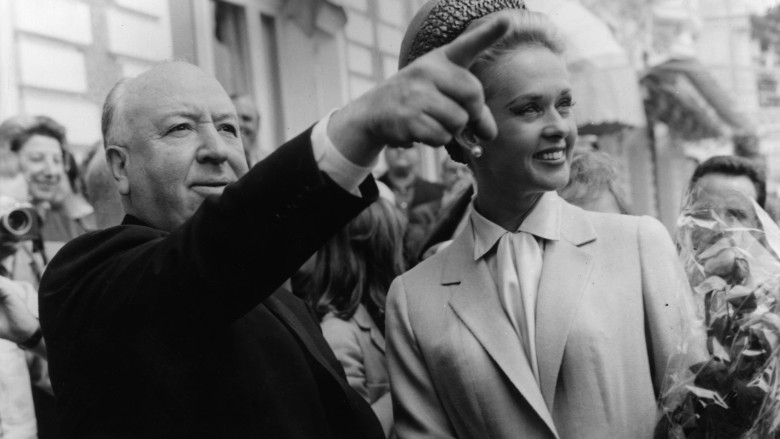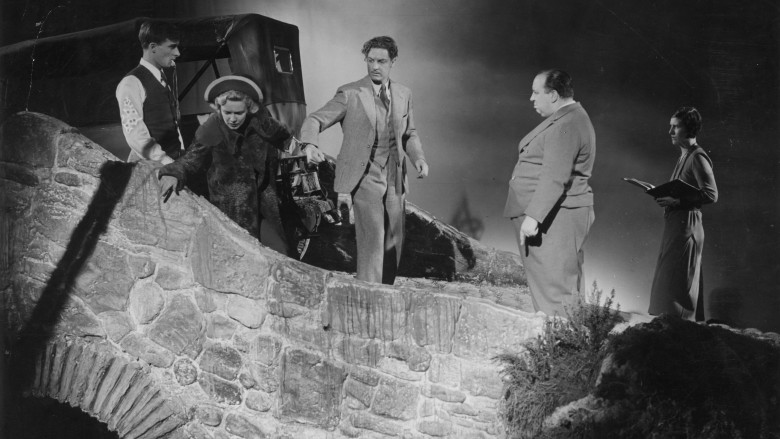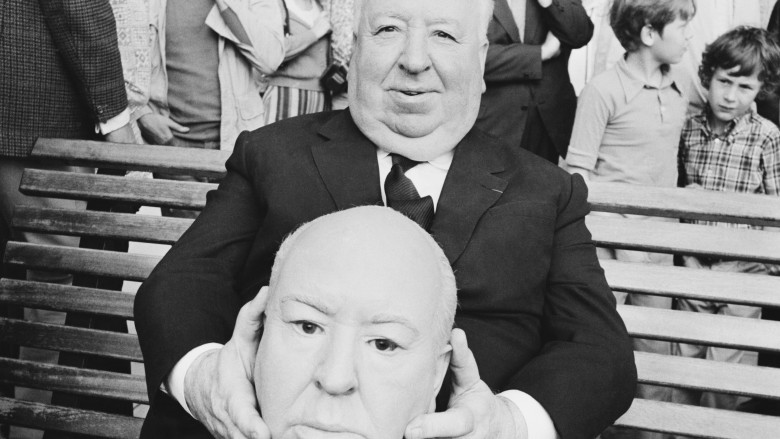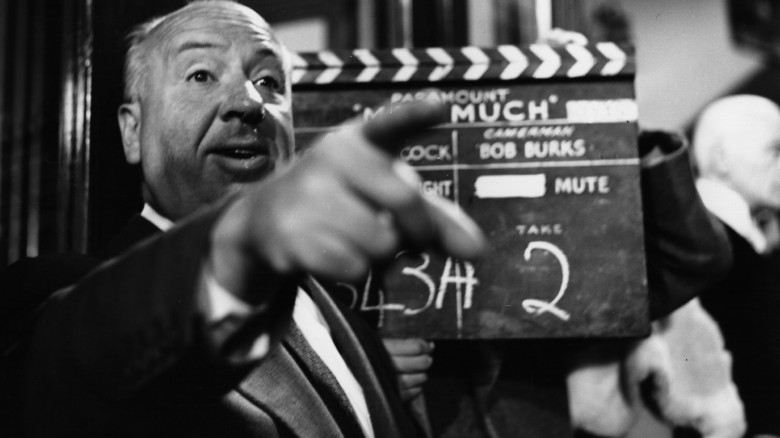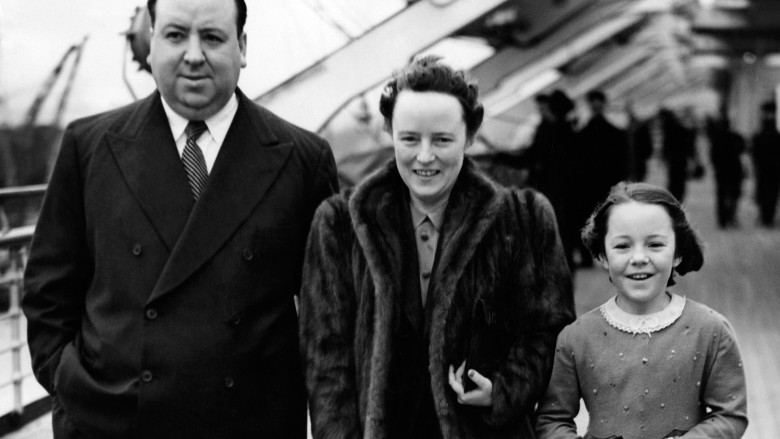Bizarre Things That Happened On The Set Of Hitchcock's Films
Hitchcock films are classic, and there's nothing better for a little late-night binge watching. Every time you watch even Psycho or The Birds again, you'll probably notice something you'd never seen before. That's because he was insane when it came to details and, some might argue, just downright insane. Hitchcock films are classic, and there's nothing better for a little late-night binge watching. Every time you watch even Psycho or The Birds again, you'll probably notice something you'd never seen before. That's because he was insane when it came to details and, some might argue, just downright insane.
Tippi Hedren's abuse claims
Even among Hitchcock's film, The Birds is one of the most famous. It was only in 2016 that leading lady Tippi Hedren's memoir gave the public a look into just what went on behind the scenes. For her, she wrote that it was nothing short of a nightmare.
The Birds was her first movie job, and she'd been offered it after Hitchcock had seen her in a commercial where she didn't even have a single line. She made an impression, though, and he ordered Universal to find her so he could offer her a contract ... along with a pin made from gold and pearls, showing a pair of birds in flight.
Creepy enough, but hey, it was the '60s, and people did things differently then. There's a fine line between "differently" and "obsessively," though, and Hedren wrote that it wasn't long after shooting started that he came to the conclusion she was losing weight. So, he did what any other obsessed fanboy would do: he sent her a basket of bread with a note that read, "Eat me." If that wasn't enough, Hedren said that his hugging and touching got to the point where she finally approached his wife, Alma, and asked her to make it all stop. According to Hedren, Alma just walked away.
After The Birds, she was cast at the title character in Marnie. She says that things only got worse from there, with Hitchcock regularly grabbing her, telling her about his dreams in which she professed her undying love for him, and his promise to ruin her if she rejected him. "It was sexual, it was perverse, and it was ugly, and I couldn't have been more shocked or repulsed," she wrote in her memoir. After Marnie, she wrote, "My soul needed to get away." She founded her own production company and big cat sanctuary, famously raising daughter Melanie Griffith among the tigers and leopards.
The very real birds in The Birds
Today, we can watch a movie and at least convince ourselves that, for the most part, any animals we see were humanely treated behind the scenes. That's not always the case, and in the '60s, it definitely wasn't the case. Actors weren't even treated humanely, what chance did birds have?
By the time they were ready to film that iconic scene with birds in the attic, Tippi Hedren had already made it perfectly clear what she thought of Hitchcock's obsession with her. According to Hedren, that week-long shoot was one of the most traumatic experiences she ever had, out of a long set of traumatic experiences. Originally, it didn't seem like anything out of the ordinary, and she'd been told that they were going to use mechanical birds.
Yeah, that was BS. "Everybody lied to me," she said, "and on the Monday morning, as we were going to start the scene, the assistant director came in and looked at the floor and the walls and the ceiling, then blurted out: 'The mechanical birds don't work, so we have to use real ones,' and then he ran out." When she got on set, she realized there apparently hadn't been any intention of using mechanical birds whatsoever, and that the entire attic was rigged so bird handlers could stand safely off-camera and spend the next week throwing actual gulls, pigeons and ravens at her. At one point, they tied a raven to her leg — the understandably freaked-out bird clawed her face in its frantic attempts to get away.
The ordeal only ended when the bruised and bloody Hedren collapsed, taken into a doctor's care. Now, she says, "I got over Hitchcock a long time ago because I wasn't going to allow my life to be ruined because of it. It was like I was in a mental prison, but now it has no effect on me. I did what I had to do to deal with it." Hero.
He handcuffed two of his actors together and 'lost' the key
In 1935, Madeleine Carroll and Robert Donat starred in Hitchcock's The 39 Steps, considered to be the film that elevated him to fame. He was already 18 movies into his career, and that was enough for him to already have elevated his own behavior from "quirky" into downright bizarre. There's a whole list of his weird behavior from behind the scenes, including reports that every time he finished a cup of tea, he wouldn't just set it on a table or hand it to an assistant like a normal person. Nope, that's too pedestrian. He'd toss it over his shoulder and smash it on the ground, just one of the bizarre ways he decided to use to show that he was in absolute control.
He reportedly called his stars "Mr. Doughnut" and "the Birmingham tart," rather than referring to them by their actual names like, again, a normal person. The first day Donat and Carroll were on set at the same time, he produced the handcuffs that would be keeping them side-by-side for a good part of the film. Slapping the cuffs on them, he went on to pretend that he'd misplaced the key. What a jokester!
There's a few different versions on how it all ended. According to Donat, he and Carroll got along too well for Hitchcock to be amused by their suffering, and he "found" the key after an hour or so. Other accounts have the hilarious gag dragging on for hours, with everyone involved getting more and more annoyed with the whole thing. Except for, of course, Hitchcock himself, who would later remark, "We had a lot of fun making The 39 Steps."
"We" meaning "he."
Skirting UN rules by using hidden cameras
Decades after its 1959 release, North by Northwest is still hailed as one of the best spy films of all time. It's notable for a few things, including being among the first films shot on location at both The Plaza Hotel and Grand Central Station ... along with, sort of, the UN.
It's probably not surprising that filming a movie at the UN wasn't entirely approved of. If there's one thing we've learned about Hitchcock, it's that he's not the type to let little things like rules and regulations (or actor's feelings) get in the way of bringing his vision to the screen. Even though filming the UN building was strictly off-limits, Hitch set up a hidden camera to get around UN security and the New York Police Department, when he was filming the shot of Cary Grant heading into the building.
Filming inside the UN was right out of the question, and there was, presumably, a problem setting up more hidden cameras inside. People tend to notice these sorts of things. The interior shots were done on a set, but it was a pretty authentic set for a pretty awesome reason. Hitch might not have been able to film the UN lobby, but he was able to put on his tourist disguise, recruit a photographer, and wander through the lobby taking pictures as though he were on what was presumably the most boring vacation ever. It worked, though, and you can't say as many people have looked at your vacation shots.
Cary Grant, Mount Rushmore, and Lincoln's nose
The UN wasn't the only iconic set in North by Northwest, and it wasn't the only set that had Hitch scrapping with government officials, either. The film is most famous for its scenes on Mount Rushmore, but getting permissions needed meant going head-to-head with the Department of the Interior. Hitch says it best himself:
"In North by Northwest during the scene on Mount Rushmore I wanted Cary Grant to hide in Lincoln's nostril and then have a fit of sneezing. The Parks Commission [sic] of the Department of the Interior was rather upset at this thought. I argued until one of their number asked me how I would like it if they had Lincoln play the scene in Cary Grant's nose. I saw their point at once."
He had liked the idea so much, the original title was The Man in Lincoln's Nose, and even though he gave up on that as the hilarious ending to the film, he was still hampered by the Park Service's insistence that filming a bunch of actors — even when Cary Grant was one of the bunch — running along the presidents' heads would be more than a little disrespectful. Finally, they agreed to allow filming to take place there, as long as there was none of the aforementioned disrespect going on. Hitchcock agreed — presumably while crossing his fingers behind his back — and permits were signed.
Unfortunately, he couldn't resist telling his real plan to a reporter, and people were outraged. While only three scenes were actually filmed on site and the rest were filmed on a Hollywood recreation of the iconic monument, the fake Mount Rushmore was so good (and press from MGM suggested that there was no fake version) that the Park Service got all worked into a tizzy. They took the issue all the way to the Senate, but because government takes an unbelievably long time to do anything, the movie was released before it could be stopped.
The Park Service did get enough of their way that they were at least appeased by the whole thing, though, and while they didn't stop the movie, they did take out a line in the credits saying they had approved the whole thing. That'll show 'em.
Moving Vermont leaves to California trees
Say what you like about Hitchcock, but he's a stickler for details. Rebuilding a Frank Lloyd Wright house and Mount Rushmore on a Hollywood set for North by Northwest cost a staggering $50,000 (that's almost half a million, adjusted for inflation) but that's nothing compared to the work that went into recreating a Vermont autumn for The Trouble With Harry.
The idea was to take a murder out of the darkness and the shadows, and move it to the sunlight of a pleasant autumn afternoon. They did, filming on location in a series of small towns in Vermont. But, as anyone who's been to New England knows, the weather's unpredictable and autumn doesn't last for long. The weather became unbearable before filming wrapped, so what's a director to do?
Filming had to finish, and by the time they were done, about half the movie was shot on a California soundstage. In order to keep the look and feel of New England, though, they collected bags and bags (and still more bags) of autumn leaves, sent them to California, and glued them to the trees on their studio set. Next time you think your job is mind-numbingly meticulous, just image the poor guys who went into work that morning to find out what was on their agenda.
Taking time out to visit children — and change lives
You might be a little suspicious of Hitchcock's ability to care for children or, at least, not scare them senseless. He was, after all, the one that thought little 6-year-old Melanie Griffith would like a doll, made to look exactly like her mother, Tippi Hedren, and dressed just like her character from The Birds. And, of course, he presented to her in a little miniature coffin. (Griffith would later say, "He was a motherf*****, and you can quote me.")
But weirdly, it wasn't all highly inappropriate gifts and stalking — cracking open Hitchcock's personal archives, you find a letter from the Wilmar Union School District from 1962. In it, principal Duncan Coleman thanks Hitchcock for taking time out of his busy filming schedule (he was shooting The Birds), and stopping by the school when on his way to set. While at the school, he visited with the kids and gave one little boy an autograph. The principal thanked him profusely, as the normally shy and withdrawn boy opened up in class for the first time since they had known him. "Many times it takes such a spark as this to help a youngster out of his shell and on the road to confidence. You don't realize what your act of kindness has done for this child," Coleman wrote.
Who'da thought? Definitely not little Melanie Griffith.
Seven months of FBI surveillance
Alfred Hitchcock Presents aired from 1955 to 1962 — 1961's Coming, Mama, was little different than the rest. It's the story of the daughter of a passive-aggressive nutter who finally decides to take the ultimate way out, and start moonlighting as a poisoner.
Dark, sure, but this is Hitchcock we're talking about, after all. It's not better or worse than any other stories he's brought to the screen, but this one kicked off seven months of FBI surveillance. The FBI conveniently had a stooge in place with Revue Studios, the company that produced Alfred Hitchcock Presents. According to that mole, Hitchcock and co. were planning on filming an "improper portrayal of an FBI agent" for the episode — then-director J. Edgar Hoover wasn't going to have any of that. Months of correspondence happened, as Hoover was determined to have the character removed from the script, and not in a mafia-hitman kind of way. Eventually, the character was changed to a private eye formerly attached to the FBI, and that was ... still not enough to keep the feds' fingers out of the show pie.
It led to seven months of surveillance, and the end of the file notes they're still going to be keeping an eye on the show and everyone involved. A few years later, when they tried to actually use an FBI character in Run for Doom, they were warned to be sure the character wasn't "harmful to the Bureau's reputation." Yikes.
Marnie's riding was incredibly dangerous — and bizarre
Pretty much nothing about Tippi Hedren's time on either Hitchcock set was easy, and for Marnie, she was put through her paces doing something ridiculously dangerous — and downright strange.
Part of the film explored Marnie's relationship with the only living creature she really trusts: her horse, Forio. Forio has a heartbreaking end, and for the scenes leading up to it, they needed to film Marnie on horseback. Just filming her actually riding the horse in question was out, apparently, so Hitch came up with the idea of putting the horse on a giant treadmill, and having Hedren ride while the horse was running on the treadmill.
Insane? Abso-frickin'-lutely. Did we also mention that there was no safety gear in place? Original attempts to put Hedren into a safety harness failed, so when she's riding during the hunt scene, there was a huge potential for that all to go incredibly — and literally — sideways. Later, Hedren said, "It was horribly dangerous — a horse on a treadmill! If he had tripped, I would have gone flying off. Hitchcock made me do such dangerous things, I'm amazed I'm still alive!"
Frankly, so are we.
Tormenting his own daughter on Strangers on a Train
Growing up as the child of someone famous has to be a weird thing, and growing up the child of Alfred Hitchcock? We can't even imagine. Patricia Hitchcock had an appearance in Strangers on a Train, and she definitely didn't get any special treatment from her father.
Part of the set was a giant Ferris wheel and, as luck would have it, she hated heights. Hitch promised her $100 if she would go for a ride, and she did. Unfortunately, the idea of being helpless on a Ferris wheel was apparently irresistible, and Hitch not only didn't give her the $100, but he waited until she was at the very top, cut the lights and the power, and left her there for an hour.
The Guardian's interview with Pat Hitchcock suggested that she hadn't been terrified in the least, and that she was used to things like that happening. Things like him painting her face like a clown at night, so she'd get up and see a monstrosity in the mirror. If that's not fatherly love, we're not sure what is. That said, even though she claimed that she wasn't scared, she also said that the question of whether or not his "pranks" had ever made her cry was, "the strangest thing I've been asked. I don't delve into myself over much." We're not entirely convinced it was all jests and japes in the Hitchcock home.
You probably missed the necrophilia in Vertigo
First, the quick and dirty recap of Vertigo. That's the one with Jimmy Stewart and Kim Novak, where Stewart's retired detective falls for Novak. She's been hired to play a character, though, and when that character dies — she falls off a church tower — Stewart continues to obsess and hooks up with Novak ... but only if she dresses and acts like the woman she was playing for the first half of the film. Confusing? Yep!
Vertigo came out in 1958, and in 1962, Hitchcock sat down with French director Francois Truffaut. It's a young director's wildest dreams, and according to The Guardian, he recorded the conversations they had. When they chatted about Vertigo, something weird happened, and it started when Hitchcock says, "I indulged in a form of necrophilia." Wait, what?
The scene he's talking about is the one where Stewart's character, Scottie, and Novak's Judy finally hook up. Scottie hesitates, though, and sends her away to pull her hair up — the same way she wore it when they first met, when she was playing the now-dead Madeleine. Hitchcock goes on to say that while Scottie waited, he got rather aroused. Then Hitchcock made Truffaut turn off the tape so he could finish the story. What gives? While we know something incredibly bizarre must have happened on set, we're going to have to let you imagine what.
Raymond Chandler vs. Alfred Hitchcock
Ever want to tell your boss exactly what you think of him? If so, you'll have a newfound respect for Raymond Chandler. In 1950, Hitchcock hired him to write the screenplay for Strangers on a Train. The story of what happened is recounted in Creatures of Darkness: Raymond Chandler, Detective Fiction, and Film Noir, and author Gene D. Phillips says Chandler — like most authors — preferred writing alone. Hitchcock had other ideas, and we all know how fond of micro-managing he was. If that sounds like a recipe for disaster, then your ears are working perfectly.
Chandler hated what he called the "god-awful jabber sessions." Things came to a head when Hitchcock was visiting Chandler at his home, and Chandler remarked — loudly — "Look at that fat bastard trying to get out of his car." There's probably no faster way to set fire to any relationship.
The movie included nothing Chandler had written, and he did take one final shot at Hitch after he read what had gotten the go-ahead. Letters of Note posted Chandler's rebuke, which included phrases like "a flabby mass of cliches." He also complains he wasted his time and that no amount of payment could make up for wasting his time. Shoulda just written another thriller, Ray.
Melons were auditioned for the stabbing sounds of Psycho
Ask anyone to name some of the most iconic scenes in movie history, and the shower scene from Psycho is guaranteed to be one of them. According to Business Insider, it's so iconic it's even been given a nickname: 78/52, in reference to the 78 setups and 52 cuts (no pun intended) that were required. Sure, you might already know plenty about it — like that chocolate sauce was used for the blood — but what about the strangest auditions ever held?
The story comes from Stephen Rebello's Alfred Hitchcock and the Making of Psycho (via The New York Times). Hitchcock wanted to get the sound effects for the stabbing 100 percent correct, so he sent the prop guy for a watermelon. Since the prop guy had been around long enough to know where this was going, he brought back a bunch of different melons, and "auditions" were held to see which one made the best sound when it was stabbed. Hitchcock closed his eyes, melons were stabbed, and he decided not on watermelon after all, but casaba. He must have liked its small, dying screams the best.
'Beaver' Cleaver glued on Mrs. Bates's corpse-hair
Jerry Mathers was the kid who played the erstwhile Beaver of Leave It to Beaver, and he also worked with Hitchcock in 1955's The Trouble with Harry, a few years before he played the Beaver. According to Fox News, he remembered Hitchcock as being extremely nice to him and always having inside information on all the best food. The fact they already knew each other makes it slightly less weird that Mathers helped with a particularly dark task: gluing the hair on the skull that would be the ill-fated Mrs. Bates.
Mathers said make-up man Bob Dawn had been hired to do some work on Leave It to Beaver at the same time Hitchcock hired him to make the skull and stunt corpse for the end of Psycho. Dawn had to glue each individual strand of hair onto the skull — which came from a medical supply company — and Mathers asked if he could help. Mathers wrote about it on his blog years later, saying, "As a young boy, I thought, what could be cooler than this!"
David O. Selznick vs. Alfred Hitchcock
Spellbound has the dubious honor of being one of Hitchcock's strangest movies, and "strangest" here means "something that's a bit out-of-character for him." It's all based on the very 1940s ideas of psychoanalysis, and since it was a little out of Hitchcock's wheelhouse, some weird help was brought in.
The movie actually had an official "psychiatric adviser" listed in the credits, and May E. Romm was hired by the film's other heavyweight: producer David O. Selznick. According to the New York Times, Selznick had a very good reason for hiring her to work on the film — she was his personal therapist. IndieWire reported Selznick had a personal stake in the film and wanted to spread the message about psychoanalysis so much he paid a huge sum — $40,000 in the '40s, or more than half a million in today's cash — for the film rights to the book. For Hitchcock's part, he pretty much ignored what Romm had to say, and any protests were met with, "My dear, it's only a movie." Not surprisingly, the collaboration — or lack thereof — pretty much ruined the already rocky relationship the two had from working together before. They never worked together again, and Hitchcock made sure he got the final word when it came time to make Rear Window. TCM suggests everything about Raymond Burr's villain was done to make him look just like Selznick. Hitchcock sure knew how to hold a grudge.

